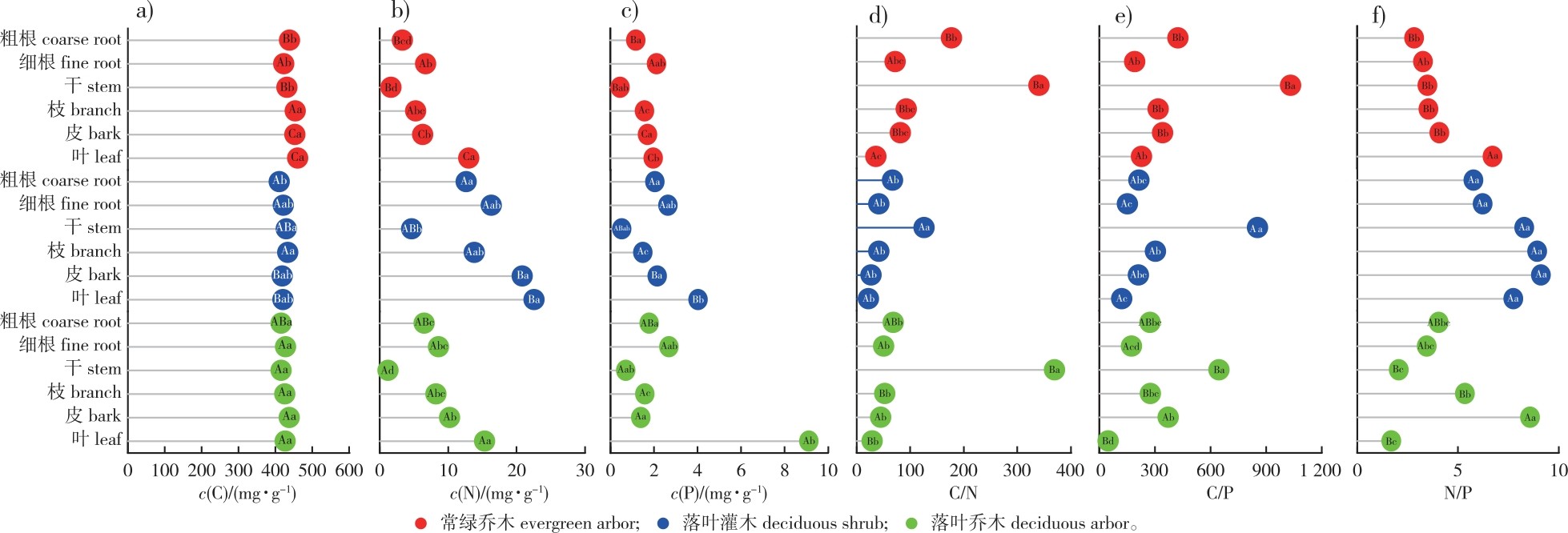 PDF(1815 KB)
PDF(1815 KB)


 PDF(1815 KB)
PDF(1815 KB)
 PDF(1815 KB)
PDF(1815 KB)
典型黑土区水土保持树种生态化学计量特征及其异速关系
Characteristics of ecological stoichiometry of soil and water conservation tree species of typical black soil region and their allometric relationship
【目的】通过研究典型黑土区水土保持树种生态化学计量特征,明确其养分利用特征及其生理适应策略。【方法】从物质分配角度,以典型黑土区常用的水土保持树种小叶锦鸡儿(Caragana microphylla)、榆叶梅(Prunus triloba)、白桦(Betula platyphylla)、糖槭(Acer saccharinum)、红皮云杉(Picea koraiensis)和樟子松(Pinus sylvestris var. mongholica)为研究对象,包括常绿乔木、落叶灌木和落叶乔木3种生活型,测定其叶、皮、枝、干、细根和粗根的碳、氮、磷质量分数[分别以c(C)、c(N)、c(P)表示],分析碳氮磷化学计量比及其异速生长关系。【结果】总体来看,碳的稳定性大于氮和磷,且落叶树种地下部分碳稳定性大于地上部分;氮的稳定性在3种生活型中均表现为地上大于地下;磷则在灌木的叶片中有最大的变异系数。c(C)表现为地上总量大于地下总量,氮、磷具有一致的分配策略,均表现为细根中含量大于粗根中含量。相关性分析表明,乔木树种的c(C)与c(N)呈正相关,与c(P)的相关性不显著;灌木树种的c(C)与c(N)呈极显著负相关,与c(P)呈显著负相关。C-N和C-P在不同器官间具有显著异速生长关系,C的积累速度大部分表现为小于N和P的积累速度;而N-P在器官间的异速生长关系差异明显,常绿乔木除皮和细根外表现为等速生长,落叶灌木的叶呈等速生长,落叶乔木的6种器官间均呈等速生长关系,且N的积累速度均小于P,落叶灌木的干和粗根以及落叶乔木的N积累速度接近于P的积累速度。【结论】植物各器官对养分元素的吸收利用具有一定的协同性,且联系紧密,可以通过研究元素之间的耦合效应来研究植物的适应策略,但限制性元素N和P的生理代谢过程在不同生活型幼苗间存在差异,因其物种本身特性差异的影响,会形成不同的营养元素分配模式及化学计量比特征。本研究结果可为水土保持植物的科学培育和典型黑土区的水土保持林营造提供理论依据。
【Objective】This study aimed to clarify the nutrient-use characteristics and physiological adaptation strategies of six commonly used soil and water conservation tree species in a typical black soil region.【Method】From the perspective of biomass allocation, six species were selected: Caragana microphylla, Prunus triloba, Betula platyphylla, Acer saccharinum, Picea koraiensis, and Pinus sylvestris var. mongholica, representing three life forms (evergreen arbors, deciduous shrubs, and deciduous trees). Mass fractions of carbon (C), nitrogen (N), and phosphorus (P) were measured in leaves, bark, branches, stems, fine roots, and coarse roots. Stoichiometric ratios (C/N, C/P, N/P) were calculated, and correlation analyses and allometric models were applied to examine relationships among element concentrations and their accumulation rates across organs.【Result】Carbon mass fractions exhibited greater stability than N and P; for deciduous species, belowground carbon stability exceeded that of aboveground parts. Nitrogen stability was consistently higher aboveground than belowground across all life forms, while the coefficient of variation for P was highest in shrub leaves. Total C mass fraction was greater in aboveground than belowground organs, whereas both N and P followed the same allocation strategy, with fine-root concentrations exceeding those in coarse roots. In tree species, C and N concentrations were positively correlated (P < 0.05), while C-P correlations were not significant; in shrub species, C correlated very significantly negatively with N (P < 0.01) and significantly negatively with P (P < 0.05). Significant allometric relationships were found for C-N and C-P across organs, with C accumulation rates generally lower than those of N and P. In contrast, N-P allometries varied by life form: evergreen arbors showed isometric growth between N and P in all organs except bark and fine roots; deciduous shrubs exhibited isometry only in leaves; deciduous trees displayed isometric N-P relationships across all six organs, with N accumulation rates consistently lower than those of P, while in stems and coarse roots of deciduous shrubs and across organs of deciduous trees, N accumulation rates were close to those of P. 【Conclusion】Nutrient uptake and utilization across plant organs are coordinated and tightly coupled, but the physiological metabolism of limiting elements N and P differ among seedlings of different life forms. Species-specific traits give rise to distinct nutrient-allocation patterns and stoichiometric characteristics. These findings provide a theoretical basis for the scientific cultivation of soil and water conservation species and the establishment of conservation forests in the typical black soil region of China.

水土保持树种 / 生态化学计量 / 养分利用特征 / 异速生长 / 黑土区
soil and water conservation tree species / ecological stoichiometry / nutrient utilization characteristics / allometric relationship / black soil region
| [1] |
闫帮国, 刘刚才, 樊博, 等. 干热河谷植物化学计量特征与生物量之间的关系[J]. 植物生态学报, 2015, 39(8):807-815.
|
| [2] |
王淳, 冀盼盼, 刘璇, 等. 华北落叶松不同器官碳氮磷化学计量特征[J]. 干旱区资源与环境, 2020, 34(11):176-181.
|
| [3] |
|
| [4] |
|
| [5] |
|
| [6] |
王凯, 雷虹, 王宗琰, 等. 干旱胁迫下小叶锦鸡儿幼苗C、N、P分配规律及化学计量特征[J]. 林业科学研究, 2019, 32(4):47-56.
|
| [7] |
|
| [8] |
|
| [9] |
常云妮, 钟全林, 程栋梁, 等. 尤溪天然米槠林植物碳氮磷的化学计量特征及其分配格局[J]. 植物资源与环境学报, 2013, 22(3):1-10.
|
| [10] |
|
| [11] |
马任甜, 方瑛, 安韶山. 云雾山草地植物地上部分和枯落物的碳、氮、磷生态化学计量特征[J]. 土壤学报, 2016, 53(5):1170-1180.
|
| [12] |
|
| [13] |
牟洪涛, 朱卫平, 崔永山, 等. 东北黑土区克山农场水土流失成因研究分析[J]. 黑龙江水利科技, 2010, 38(3):65-66.
|
| [14] |
田地, 严正兵, 方精云. 植物化学计量学:一个方兴未艾的生态学研究方向[J]. 自然杂志, 2018, 40(4):235-241.
|
| [15] |
景国臣, 刘丙友, 刘绪军, 等. 黑土区主要水土保持林现状及其功能评价[J]. 水土保持应用技术, 2012(6):36-38.
|
| [16] |
王庆彬. 漫川漫岗黑土区水土保持林树种苗木水分适应性研究[D]. 哈尔滨: 东北林业大学, 2008.
|
| [17] |
顾汪明, 周金星, 王彬, 等. 冻融循环作用对黑土水稳性团聚体特征的影响[J]. 中国水土保持科学, 2020, 18(4):45-52.
|
| [18] |
张韫. 土壤·水·植物理化分析教程[M]. 北京: 中国林业出版社, 2011:53-58.
|
| [19] |
邢磊, 刘成功, 李清河, 等. 基于白刺个体大小的生态化学计量模型[J]. 应用生态学报, 2020, 31(2):366-372.
|
| [20] |
杨清平, 陈双林, 郭子武, 等. 摘花和打顶措施对毛竹林下多花黄精块茎生物量积累特征的影响[J]. 南京林业大学学报(自然科学版), 2021, 45(2):165-170.
|
| [21] |
|
| [22] |
吴鹏, 崔迎春, 赵文君, 等. 喀斯特森林植被自然恢复过程中土壤化学计量特征[J]. 北京林业大学学报, 2019, 41(3):80-92.
|
| [23] |
罗绪强, 张桂玲, 杜雪莲, 等. 茂兰喀斯特森林常见钙生植物叶片元素含量及其化学计量学特征[J]. 生态环境学报, 2014, 23(7):1121-1129.
|
| [24] |
|
| [25] |
杨婷, 钟全林, 李宝银, 等. 3种功能型林木幼苗叶片与细根碳氮磷化学计量特征及其异速关系[J]. 应用生态学报, 2020, 31(12):4051-4057.
|
| [26] |
宋语涵, 张鹏, 金光泽. 阔叶红松林不同演替阶段灌木叶片碳氮磷化学计量特征及其影响因素[J]. 植物生态学报, 2021, 45(9):952-960.
|
| [27] |
|
| [28] |
|
| [29] |
高凯, 朱铁霞, 刘辉, 等. 去除顶端优势对菊芋器官C、N、P化学计量特征的影响[J]. 生态学报, 2017, 37(12):4142-4148.
|
| [30] |
马玉珠, 钟全林, 靳冰洁, 等. 中国植物细根碳、氮、磷化学计量学的空间变化及其影响因子[J]. 植物生态学报, 2015, 39(2):159-166.
|
| [31] |
|
| [32] |
郭浩, 庄伟伟, 李进. 古尔班通古特沙漠4种短命植物生物量与化学计量特征[J]. 西北植物学报, 2019, 39(12):2263-2270.
|
| [33] |
|
| [34] |
|
| [35] |
杨勇, 许鑫, 徐玥, 等. 黔北优势植物对槽谷型喀斯特生境的适应策略:基于功能性状与生态化学计量相关联的证据[J]. 地球与环境, 2020, 48(4):413-423.
|
| [36] |
王瑞禛, 罗丽莹, 孙嘉伟, 等. 会同成熟杉木器官C∶N∶P生态化学计量的动态特征[J]. 中南林业科技大学学报, 2020, 40(4):64-71.
|
| [37] |
|
| [38] |
蔡年辉, 唐军荣, 车凤仙, 等. 云南松苗木碳氮磷化学计量特征的构件效应[J]. 东北林业大学学报, 2022, 50(2):35-42,48.
|
/
| 〈 |
|
〉 |